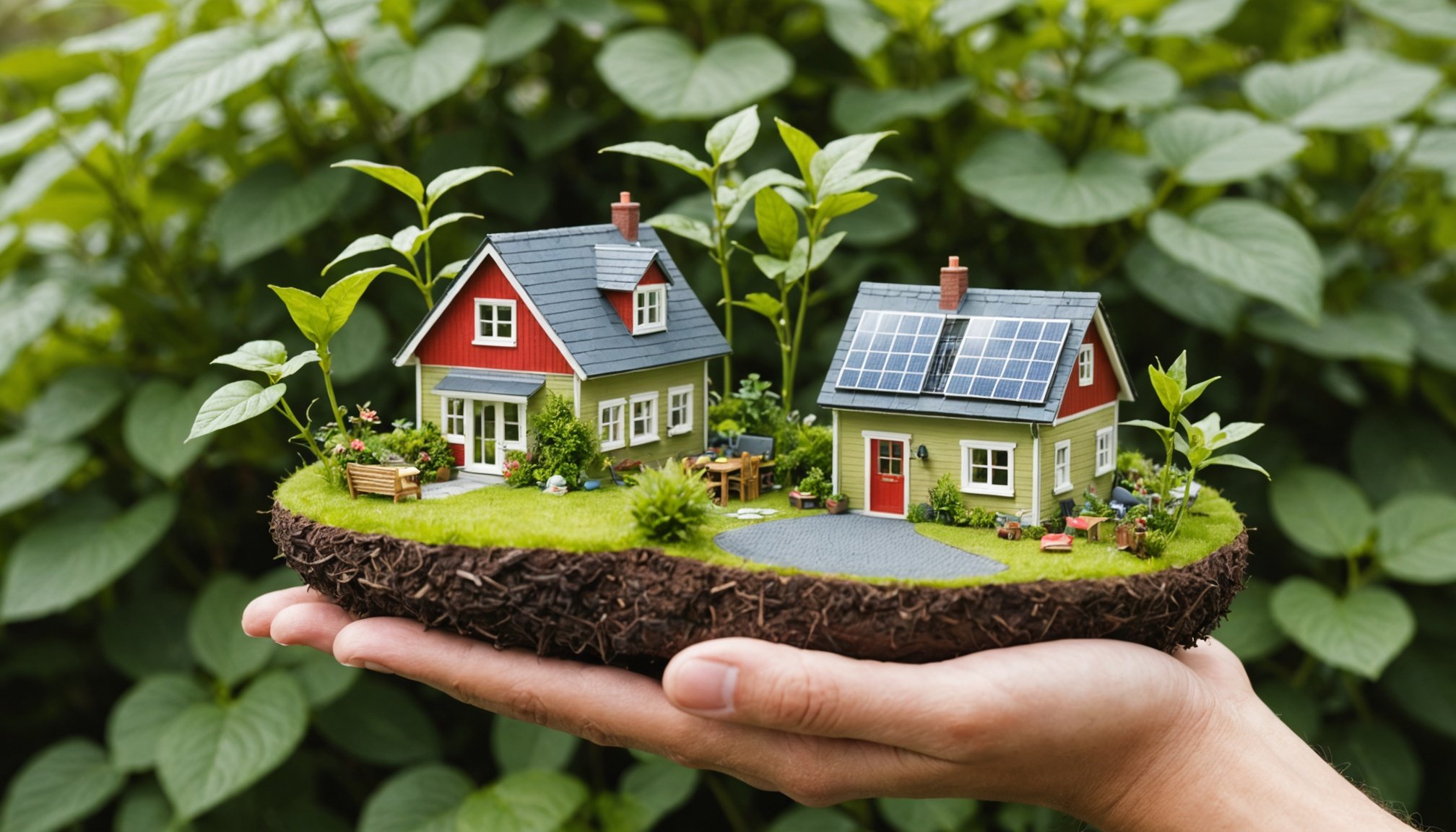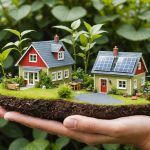Understanding Sustainability in Property Ownership
Sustainability in property ownership refers to the practice of incorporating eco-friendly measures that enhance property value while reducing environmental impact. It is an approach aimed at meeting present needs without compromising the ability of future generations to meet theirs. The significance of sustainability is growing as consumer preferences increasingly favour eco-friendly living. As more individuals become aware of their carbon footprints, they demand properties that reflect their values and contribute to a greener planet.
These changes in consumer behavior have substantial implications for property owners. Embracing sustainable practices not only aligns with ethical responsibilities but also enhances the long-term value and appeal of properties. Sustainable properties often attract higher-quality tenants or buyers who are willing to pay more for eco-efficient homes.
In parallel : Eco-friendly upgrades made easy: funding your london home”s green retrofit revolution
Moreover, there are tangible benefits to adopting sustainability. These include reduced energy costs through efficiency measures, improved indoor air quality, and lower maintenance expenses due to the durable nature of sustainable materials. Property owners can also benefit from various financial incentives designed to support eco-friendly upgrades, further enhancing property value.
In light of these aspects, the integration of sustainability in property ownership is not merely a trend but a valuable investment strategy for the future.
Also read : Revamping uk homes for multi-generational living: a comprehensive landlord”s blueprint for enhancement
Sustainable Building Materials
Incorporating sustainable materials into construction projects is a key facet of modern eco-friendly practices. These materials are designed to reduce the ecological footprint, enhance property value through durability, and align with green building standards. Sustainable materials can range from recycled metals, bamboo, and reclaimed wood, to eco-friendly cement.
Comparing Traditional Materials to Sustainable Alternatives
Traditionally, building materials such as concrete and steel have been staples in construction, but they come with a high environmental cost due to their manufacturing processes. In contrast, sustainable alternatives often use fewer resources and have longer lifespans. For instance, bamboo is a popular sustainable choice, offering strength akin to traditional timber but growing at a significantly faster rate.
Case Studies of Successful Property Renovations
Across the UK, several properties have embraced eco-friendly construction methods. One notable example is the renovation of an old cottage into a energy-efficient home using reclaimed bricks and natural insulators. These projects not only improve the environmental impact but also elevate the property value by appealing to eco-conscious buyers. Such successful renovations illustrate the potential of sustainable materials to transform properties sustainably while keeping future impacts in check.
Energy-Efficient Upgrades
Implementing energy efficiency in buildings is a crucial step for property owners aiming to enhance property value and reduce utility costs. These upgrades, which include insulating solutions, renewable energy sources, and smart home technologies, play a significant role in sustainable living.
Insulation Solutions
Effective insulation can drastically decrease energy consumption by maintaining desired indoor temperatures. Options such as eco-friendly fiberglass, cellulose, and foam are popular due to their high thermal resistance and minimal environmental impact. Incorporating these materials not only lowers energy bills but also increases property value through improved energy efficiency.
Renewable Energy Sources
Renewable sources, particularly solar panels, have become increasingly accessible. These systems convert sunlight into electricity, significantly reducing reliance on nonrenewable energy sources. Government incentives further alleviate installation costs, making this a financially viable green upgrade for property owners.
Smart Home Technologies
Integrating smart technologies like programmable thermostats and energy management systems enhances control over home energy use. These devices not only optimise energy consumption but also provide real-time data insights for continual efficiency improvements. By choosing these cost-saving measures, property owners can meet eco-friendly standards while boosting long-term market appeal.
Financial Incentives and Grants
In the realm of property ownership, the financial dimension of adopting eco-friendly practices plays a pivotal role. From government grants to tax incentives, there’s a wealth of financial assistance aimed at encouraging sustainable development.
The UK government offers various schemes to assist property owners. The Green Homes Grant, for example, provides funding for homeowners to implement insulation, renewable energy installations, and more. By utilising such funding opportunities, property owners can significantly offset the upfront costs associated with sustainable upgrades.
Beyond governmental support, certain non-profit organisations also provide financial backing for projects focusing on energy efficiency and reduced carbon footprints. This includes rebates for energy-efficient appliances and discounts for sustainable building materials. The overall aim is to make sustainability not just an ethical choice, but a financially attractive one.
Investing in sustainability yields tangible monetary perks. Enhanced property value, reduced utility bills, and increased market demand are just a few of the benefits. As more consumers lean towards eco-conscious living, the financial advantages of upgrading to greener solutions are becoming more pronounced. Embracing these incentives encourages a shift towards a more sustainable future for all.
Case Studies of Successful Implementations
The journey to integrating sustainability within property ownership is rich with stories of transformative impact across the UK. These successful projects not only enhance property value but also inspire wider community change and demonstrate practical applications of eco-friendly practices.
Consider a coastal cottage transformation in Cornwall, where the homeowner embraced sustainable materials like recycled stone and solar energy systems. This project reduced energy consumption by half, incredibly boosting the sustainability impact on both the environment and the property’s appeal. Such examples underscore how homeowner experiences reveal not just financial benefits but also enhanced living quality.
Another case involves a modern apartment complex in London that implemented advanced energy efficiency measures. By retrofitting with smart technologies and localised green spaces, property value increased, drawing in eco-conscious tenants eager to reduce their carbon footprint. This enhances demand, leading to quicker occupancy rates and increased rental income.
These projects highlight lessons learned: the importance of a comprehensive plan, the long-term cost benefits of sustainable upgrades, and the positive social implications. As these cases illustrate, embracing sustainability can lead to lucrative outcomes while encouraging a collective shift towards more responsible living choices.
Actionable Steps for Property Owners
To embrace sustainability, property owners must take practical steps toward creating an eco-friendly environment. Here’s a sustainability action plan to consider:
-
Prioritise Projects: Evaluate which eco-friendly projects best suit your property, budget, and goals. Begin with simple measures like upgrading insulation or installing smart thermostats for immediate cost savings and energy efficiency improvements.
-
Research Resources: Seek guidance from reputable sources that specialize in sustainability. Numerous organisations and websites provide invaluable tools and support, helping you navigate the transition towards sustainable practices effortlessly.
-
Implementation Road Map: Establish a clear timeline that outlines each phase of the project. This roadmap facilitates efficient execution and allows property owners to track progress, ensuring timely completion of each step.
-
Budget Considerations: Identify available government incentives or grants that could subsidise costs. Eco-friendly funding can reduce financial burdens and enhance your ability to implement high-impact projects.
-
Community Engagement: Actively engage with like-minded homeowners and local sustainability groups. Sharing experiences and advice with others on a similar journey fosters invaluable connections and encourages collective efforts towards a greener community.
By following these structured strategies, property owners can successfully navigate their journey toward sustainable living.
Statistics on Eco-Friendly Living Trends
Eco-friendly living trends are reshaping the property market, driven by shifting consumer behaviours and sustainability statistics. An increasing number of eco-conscious consumers prefer properties that incorporate green features. Reports indicate that around 70% of UK buyers consider sustainability a crucial factor in their decision-making. These market trends reflect a growing awareness of environmental issues and promote property designs that reduce carbon footprints.
Understanding these statistics helps predict future sustainability in property ownership. Property values for homes with energy-efficient features, like solar panels or quality insulation, have shown significant increases. This is not only attributed to immediate cost savings but also to the long-term impact of reducing environmental footprints. As the demand for eco-friendly properties rises, industry experts predict continued growth in this area, suggesting that sustainable property investments will remain lucrative.
For property owners, keeping abreast of these trends offers a strategic advantage. Incorporating sustainability into property marketing effectively, by highlighting eco-friendly features and demonstrating long-term benefits, attracts the discerning buyer increasingly dominating the market.
By staying informed and responsive to these trends, property owners can ensure their investments remain appealing and relevant in an evolving marketplace.
Tips for Increasing Property Appeal
Emphasising sustainability features can significantly boost a property’s marketability. Highlighting these attributes effectively attracts eco-conscious buyers, who are increasingly valuing green homes. Start by showcasing the tangible benefits of energy efficiency; reduced utility expenses and improved indoor environments are notable selling points.
Engaging potential buyers involves clearly displaying eco-friendly upgrades like renewable energy solutions, efficient appliances, and smart home technologies. This can be visually achieved through virtual tours or interactive displays that provide detailed insights into the property’s sustainable elements. Additionally, emphasising the use of sustainable materials in construction or renovations offers lasting durability, appealing to buyers who prioritise long-term investments.
Invest in strategic marketing techniques. Leverage digital platforms to disseminate information about a property’s unique eco-friendly practices, utilising storytelling to illustrate the impact on lifestyle and environmental conservation. In property listings, ensure key sustainable features are prominently mentioned, making the property stand out in a competitive market.
Finally, staying informed about market trends ensures effective property promotion. Understanding buyer preferences and sustainability statistics will guide owners in maintaining the property’s relevance amidst evolving consumer behaviours. Implementing these strategies can enhance property value while aligning with future-oriented buyer expectations.
Resources for Further Information
Navigating the realm of sustainability in property ownership can be complex, but a wealth of educational resources is available to guide you. Leading sustainability organizations in the UK, such as the UK Green Building Council, offer invaluable insights into eco-friendly practices and innovative approaches to property management. These organizations provide a platform for learning and connecting with professionals committed to promoting sustainability.
For continuous learning, various informative websites are dedicated to sustainable living. Websites like the Energy Saving Trust deliver resources on renewable energy and energy efficiency, while other platforms offer comprehensive guides on implementing green grants and incentives.
Additionally, accessing industry-leading publications and reports keeps property owners informed of market trends and sustainability statistics. Publications such as Green Building Magazine and Sustainable Homes provide regular updates and case studies that illustrate the success of sustainability initiatives in property settings.
By leveraging these educational resources, property owners can stay informed of advancements in eco-friendly methods and align their properties with current market demands. Engaging with these efforts not only enhances property value but also contributes to a broader movement towards a more sustainable future.






